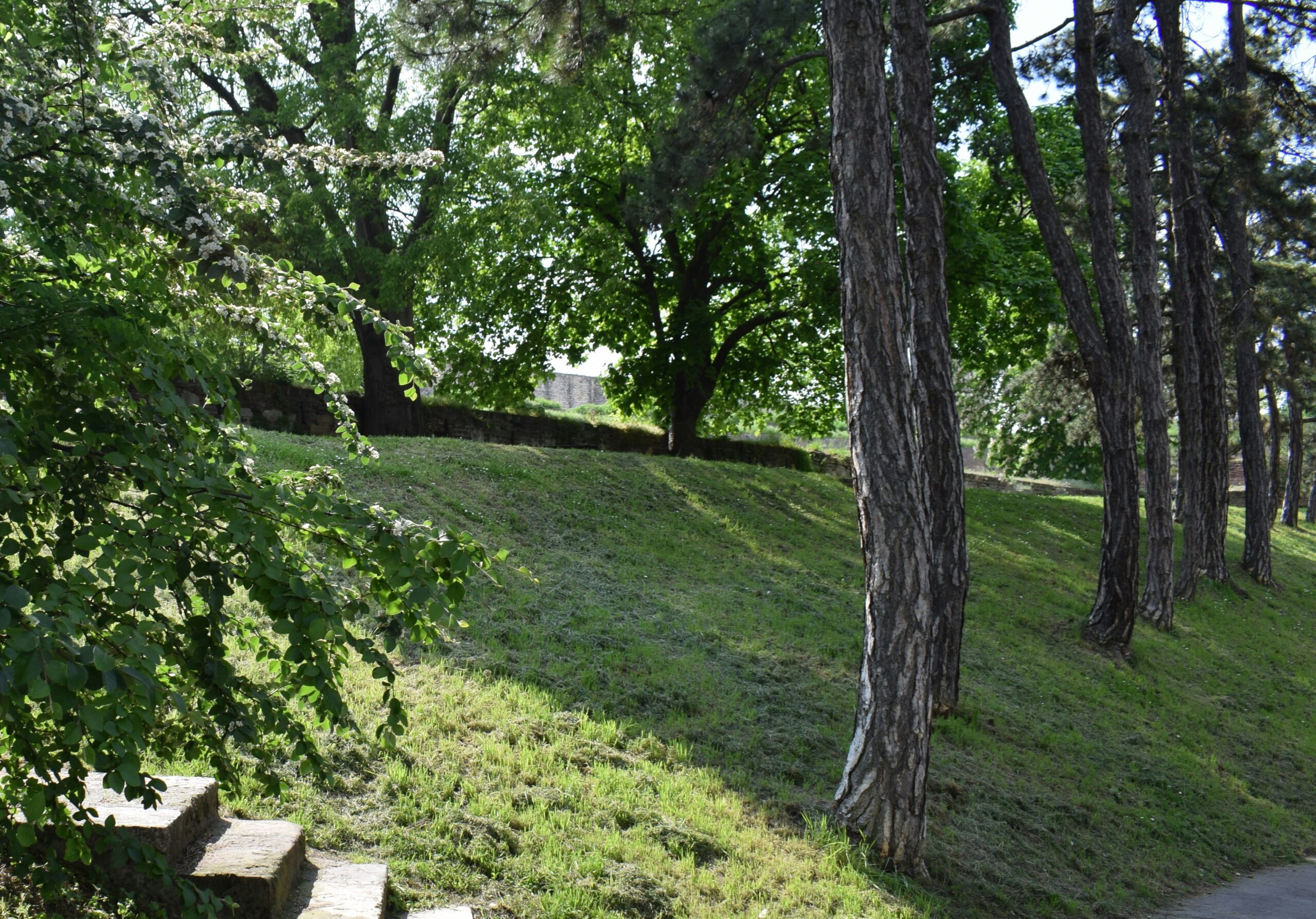This article provides ideas for maximising your sloped garden space. Whether you’re dealing with a gentle incline or a steep hillside, you’ll find practical tips on building terraces, choosing erosion-preventing plants, and incorporating other elements to enhance the beauty and functionality of your outdoor space.
With a bit of planning and the right approach, you can turn that slope into an eye-catching feature. Let’s explore ways to make the most of your sloped garden.
What to Consider With a Sloped Garden
When planning a garden on a slope, understanding the terrain is crucial:
- Sloped gardens can suffer from soil erosion and water runoff, which can lead to difficulty in maintaining a space and also a lack of water reaching plants
- Assess the soil type, slope gradient, and sun exposure to understand the terrain and how to maintain plant health.
- Retaining walls or terraces can convert a steep slope into manageable, usable space.
Tip from a Landscape Gardener: Incorporate a series of interconnected terraces, each with its own microclimate, to maximise the use of space and create visual interest. This not only prevents soil erosion but also allows for diverse planting opportunities that can be adjusted based on sun exposure and accessibility.
Ideas for Sloped Gardens
Transforming a sloped garden into a vibrant and usable space requires thoughtful design.
Below are 19 creative ideas that tackle common issues associated with sloping terrains, such as erosion, accessibility, and aesthetics.
1. Tiered Terraces
Building terraces is a classic and highly effective way to manage a sloped garden. By creating flat areas on different levels, you can prevent soil erosion and make planting easier.
Implementation: Use retaining walls made from stone or wood to hold back the soil. Each tier can feature different types of plants, from shrubs on higher levels to flowers on lower ones.
Expert Tip: Ensure proper drainage behind each retaining wall to prevent water pressure from causing damage.
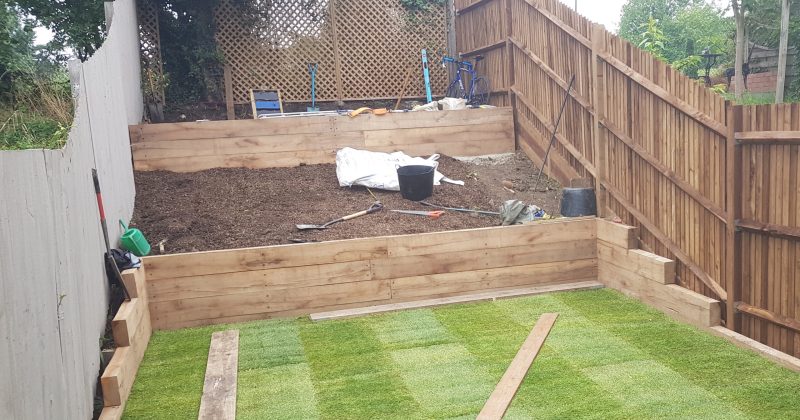
2. Ground Cover Plants
Planting ground cover plants helps stabilise the soil and prevent erosion, a common issue on slopes.
Implementation: Plant fast-growing ground covers like creeping thyme, periwinkle, or juniper. These plants spread quickly, covering bare spots and reducing maintenance needs.
Expert Tip: Choose native ground covers that will thrive in your local climate and soil conditions, providing a low-maintenance and eco-friendly option.

3. Rock Gardens
Rock gardens are perfect for sloped areas as they require minimal soil and help in controlling erosion.
Implementation: Arrange large rocks strategically and fill in with soil and succulent plants or other drought-resistant species that thrive in rocky conditions.
Expert Tip: Install a drip irrigation system within the rock garden to ensure that plants receive adequate water without excessive runoff.

4. Water Features
Install water features such as cascading waterfalls or streams, which naturally suit sloped gardens and help manage water flow aesthetically.
Implementation: Design the water feature to follow the natural slope of your garden, using it to channel water runoff effectively. This can also create a tranquil environment and attract wildlife.
Expert Tip: Position pumps and filters strategically to maintain water circulation and quality, preventing stagnation even in the smaller pools.
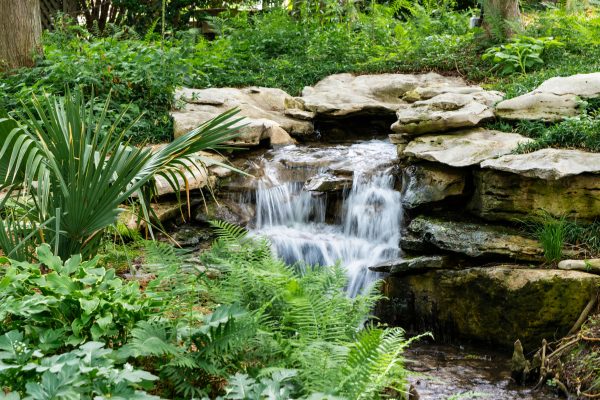
5. Stairways and Steps
Installing stairs to your sloped garden will improve its accessibility while adding a dynamic architectural element to the garden.
Implementation: Use materials like stone, wood, or concrete to construct steps that blend with the natural surroundings. Add handrails for safety and lighting for evening aesthetics.
Expert Tip: Ensure that steps have a rise of no more than 6 inches for comfort and safety, especially in steep areas.
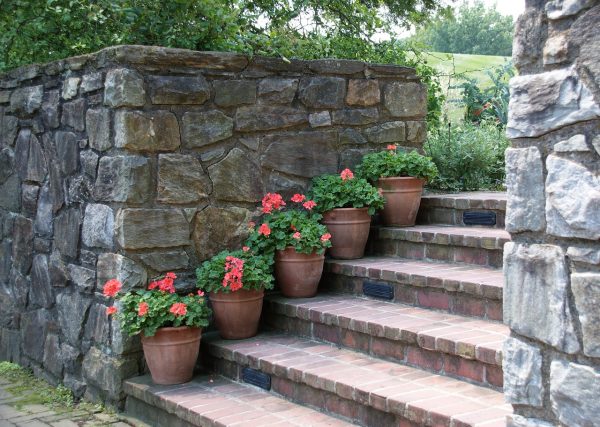
6. Pathways with Borders
Pathways are practical for navigating through the garden and can also visually divide different areas.
Implementation: Use gravel or mulch for the pathway and edge it with bricks, stones, or wood to keep materials in place and add a tidy look.
Expert Tip: Pathways should follow the contour lines of your slope to minimise excavation and feel more natural within the landscape.
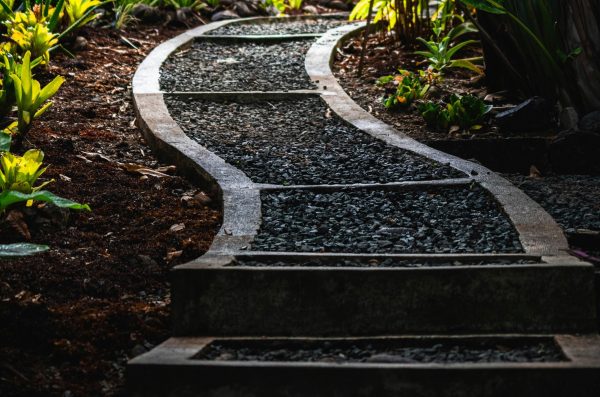
7. Retaining Walls with Seating
Retaining walls are essential for managing soil erosion but can be enhanced by adding a seating area.
Implementation: Build retaining walls at a height that is comfortable for seating (about 18-20 inches). Top them with flat stones or capstones that provide a smooth surface for sitting.
Expert Tip: Add drainage points within the retaining walls to prevent water buildup and help ensure longevity.
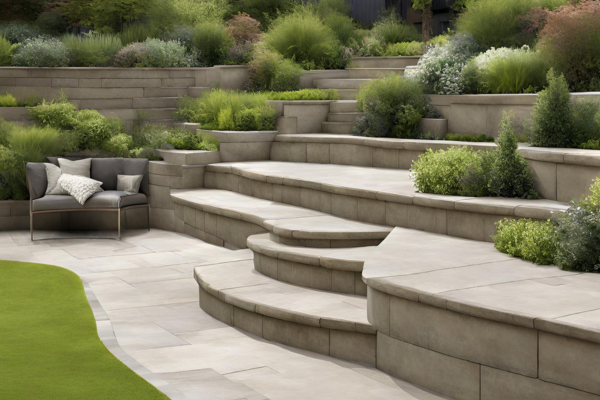
8. Raised Planting Beds
Raised beds can help control soil erosion and make gardening on a slope easier by bringing the soil level up and reducing the angle of the garden surface.
Implementation: Construct raised beds with non-permeable barriers and support frames that contour to the slope. Fill them with rich soil and compost to support diverse plant life.
Expert Tip: Align your raised beds along the contour lines of your slope to minimise water runoff and maximise soil retention.

9. Use Railway Sleepers
Railway sleepers are sturdy and aesthetically pleasing materials that can be used to create steps, paths, or even retaining walls on a sloped garden.
Implementation: Lay the sleepers horizontally or vertically into the slope to create terraced beds or steps. Secure them properly to prevent movement over time by levelling the ground, hammering robust stakes into the ground at intervals, attaching the sleepers to these stakes with screws, and backfilling with gravel for additional stability.
Expert Tip: Treat wooden sleepers with a weather-resistant sealant to prolong their life against moisture and soil contact.

10. Swales and Permaculture Techniques
Swales are shallow trenches that follow the contour lines of a slope and are filled with absorbent material, like compost, mulch or gravel, to capture and redistribute water, improving irrigation.
Implementation: Dig shallow trenches along the natural lines of your slope to form swales, typically about 1 to 2 feet deep (30 to 60 cm) and 3 to 5 feet wide (about 1 to 1.5 metres). Fill these trenches with layers of straw and mulch, which help absorb and retain water, allowing it to slowly permeate into the soil and nourish your plants. Space the swales closer together on steeper slopes and further apart on gentler ones.
Expert Tip: Pair swales with simple permaculture practices to boost your garden’s health. Try planting different types of plants together, using layers of tall and short plants, and choosing plants that come back year after year. This setup helps your garden take care of itself, saving you time and increasing the garden’s yield.

11. Ornamental Grasses
Ornamental grasses have deep root systems that help stabilise the soil and prevent erosion on steep slopes.
Implementation: Plant clumps of ornamental grasses such as Miscanthus, Fountain Grass, or Blue Fescue along the slope. Their foliage and flowers also add movement and interest to the garden landscape.
Expert Tip: Choose grasses that are native to your area, as they will be more drought-resistant and require less upkeep.
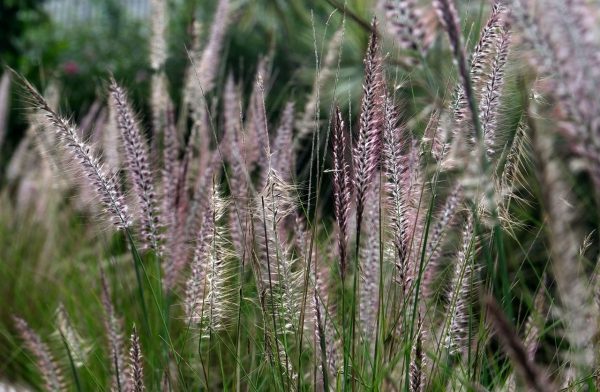
12. Create Terraces with Gabion Walls
Gabion walls are cages or baskets filled with rocks, concrete, or sometimes sand and soil. They are made from strong, galvanised wire mesh that can withstand environmental elements, providing a strong, stylish, and drainage-friendly way to terrace steep slopes.
Implementation: Construct cages from galvanised steel and fill them with stones or recycled concrete. These walls can then be used to create flat terraces for planting or leisure areas.
Expert Tip: Ensure proper drainage behind the gabion walls to prevent waterlogging, which can weaken the structure over time.
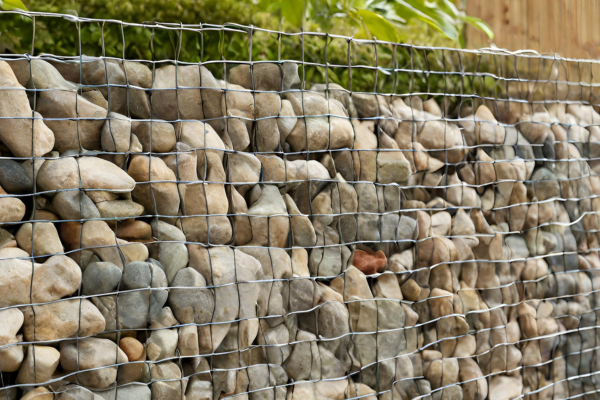
13. Slope Lighting
Installing lighting within a sloped garden can enhance the visual appeal during the evening and improve safety by illuminating paths and steps.
Implementation: Use solar-powered lights along pathways or LED spotlights to highlight trees, sculptures, or water features. Position lights also illuminate steps and uneven areas to prevent trips and falls.
Expert Tip: Choose lighting fixtures designed for outdoor use to withstand weather elements and consider timer options to save energy.
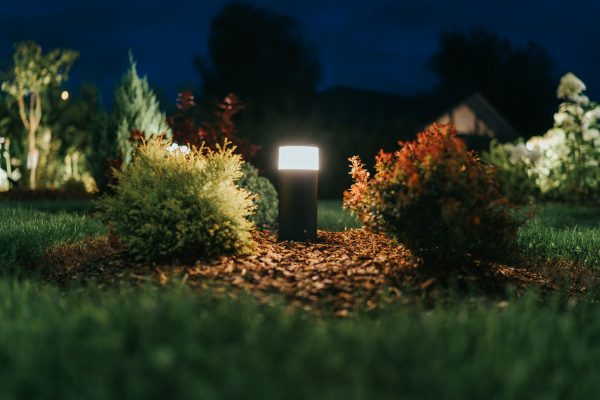
14. Seating Areas
Follow the unique contours of your slope to create interesting seating areas that offer different views of your garden.
Implementation: Position benches and seats at varying heights and orientations on the slope, perhaps under a tree or facing a particularly beautiful section of the garden.
Expert Tip: Build seating into retaining walls or raised beds for a seamless, natural look that compliments your landscaping.
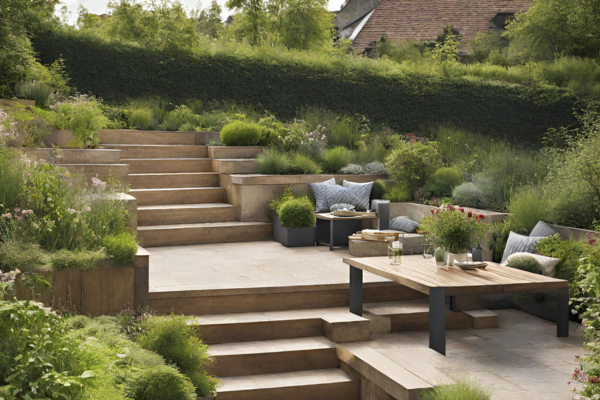
15. Stone Pathways
Stone pathways are not only charming but also practical for sloped gardens, providing stable footing and effective drainage.
Implementation: Lay stones with slight gaps filled with gravel or moss to allow for water permeation. Ensure the path has a slight incline to channel water away from walkways and planting areas.
Expert Tip: Use local stones to maintain the natural aesthetic of your landscape and install a French drain system — a trench filled with gravel or rock containing a perforated pipe that redirects surface water and groundwater away — underneath the pathway for enhanced drainage.
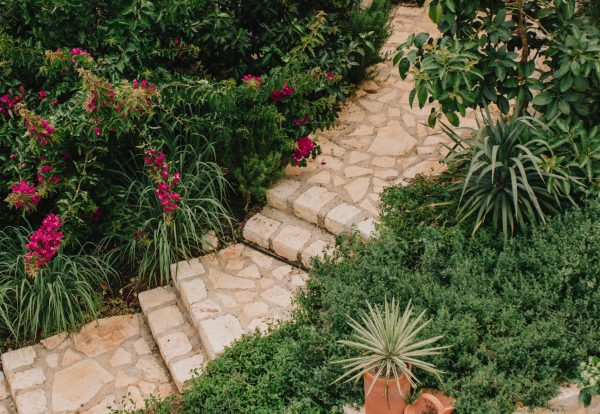
16. Vertical Gardening
Turn the challenge of a sloped garden into an opportunity by installing vertical gardens, which add decorative beauty to your sloped garden.
Implementation: Use climbing frames, trellises, or hanging planters to make the most of the vertical space. Aesthetical flowering vines are ideal for adding a wow factor to your sloped garden.
Expert Tip: Select plants that thrive in vertical conditions, such as climbing roses, to create a lush and productive garden.
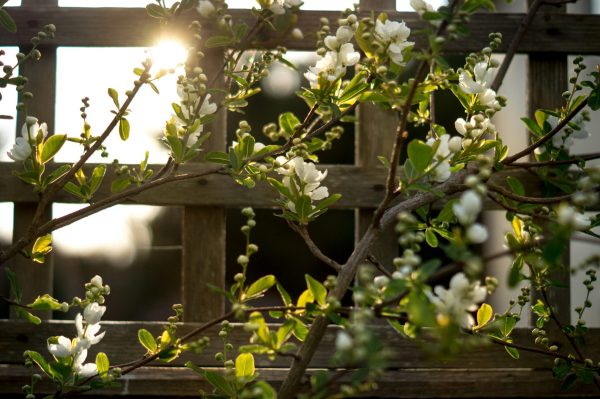
17. Drought-Resistant Planting
Optimise water use and minimise maintenance by choosing drought-resistant plants suitable for sloped conditions.
Implementation: Select species adapted to your local climate that can thrive with minimal water, such as lavender, sedum, or sage. Arrange them in aesthetically pleasing patterns that also function to stabilise the slope.
Expert Tip: Mulch around the plants to help retain moisture in the soil and reduce the need for frequent watering.

18. Edible Slope Gardens
Transform your sloped garden into a productive edible landscape that makes use of the vertical space to grow a variety of fruits, vegetables, and herbs.
Implementation: Design the slope with alternating rows of deeper-rooted plants like tomatoes and shallow-rooted herbs to naturally terrace the area, using companion planting to optimise space and nutrient usage. Incorporate organic mulches and a drip irrigation system to maintain even moisture levels and soil fertility.
Expert Tip: Plant perennial crops such as berries and asparagus on the steeper parts of your slope to reduce soil disturbance and promote a stable, self-sustaining garden ecosystem.
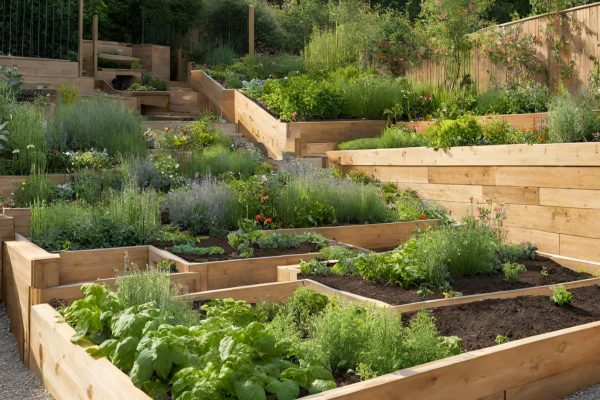
19. Sloped Zen Garden
Create a serene and contemplative Zen garden on your slope, combining elements of traditional Japanese garden aesthetics with the natural gradient of your land.
Implementation: Use sand or fine gravel as the base material to represent water, raking it into calming patterns that flow down the slope. Integrate larger rocks and boulders to symbolise mountains and islands, and plant moss or low-growing ground covers to add greenery and prevent erosion.
Expert Tip: Orient your Zen garden elements in harmony with the slope’s natural lines, allowing paths and patterns to guide the eye gently downhill, which can visually amplify the peacefulness of the setting.

FAQs About Slanted Gardens
Q: How do you make a sloped garden look good?
A: To enhance the appearance of a sloped garden, consider using terracing to create flat areas for planting and leisure. To add depth and interest, incorporate a variety of plants with different heights and colours, such as shrubs, ground covers, and ornamental grasses. Strategically place pathways and features like benches or sculptures to help draw the eye and make the space more inviting.
Q: How do you level a sloping garden in the UK?
A: Levelling a sloping garden typically involves cutting and filling to create terraces, which are retained by walls made from stone, wood, or concrete blocks. Proper drainage is also important to prevent water logging.
Q: How do you landscape a steep slope on a budget in the UK?
A: Landscaping a steep slope on a budget can be done by using cost-effective materials like railway sleepers for retaining walls, opting for native or self-seeding plants to reduce the need for purchase and maintenance, and implementing DIY projects such as homemade terraces or rock gardens.
Q: What is the best plant to plant on a slope?
A: The best plants for a slope are those that have deep root systems to help stabilise the soil and are hardy enough to thrive in the local climate. This includes various types of grasses, such as fescue or ryegrass, and ground covers like creeping juniper or ivy.
Q: What are the issues with a sloping garden?
A: Issues with a sloping garden include soil erosion, water runoff, difficulty in accessing and using the space, and challenges in planting and maintenance due to the angle of the land.
Q: What is the fastest-growing ground cover for slopes
A: Fast-growing ground covers for slopes include creeping thyme, periwinkle (vinca minor), and daylilies. These plants spread quickly, hold the soil effectively, and require minimal maintenance, making them ideal for slope stabilisation.
Let Green Team Landscaping Design Your Dream Garden
Need help to transform your sloped garden? We are here to create a garden that fulfils your dreams. Learn more about our tailored landscaping services, and let us help you maximise the potential of your sloped garden. Let’s bring your vision to life!

